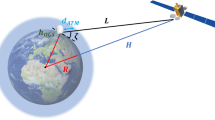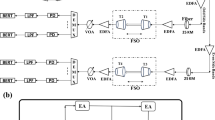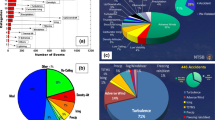Abstract
The forecast of rain rate and the accompanying attenuation is a crucial factor for analyzing the efficacy of a terrestrial-based ‘Free Space Optical’ communication technology. The optical beam in a terrestrial-based FSO communication system commonly propagates through open air, where it is susceptible to atmospheric hazards like rain, dust, fog, snow, etc., as a result, the optical beam is diminished by these hazards. In this paper, experimentation has been carried out in the developed artificial rain simulation chamber with a 980 nm Laser source. The considered modulated Laser beam propagates in the different rain rates that are generated by the artificial rain simulation chamber. The obtained optical power attenuation for wavelength (980 nm) is compared with other existing conventional models and developed a new rain attenuation model. With the research of optical power attenuation, the impact of various rain rates on communication channels has been investigated as well, and eventually, an optical power attenuation mitigation strategy known as the "Aperture Averaging" technique has been Introduced in the system. As a consequence, the optical link performance has been improved significantly in terms of received optical power, signal-to-noise ratio, bit error rate, etc., at different rain rate scenarios.



















Similar content being viewed by others
References
J Guo and X J Zhao Optik 127 9088 (2016).
Y Ruike, H Xiange and H Yue Int J Infrared Milli Waves 28 181 (2007)
A K Majumdar and J C Riclkin Free space Laser communications: Principles and Advances, 1st edn. (New York: Springer) (2007)
H Kaushal, V K Jain and S Kar Free Space Optical Communication, 1st edn. (Berlin: Springer) (2017)
G G Soni, A Tripathi, M Shroti and K Agarwal Optical and Quantum Electronics 55 1 (2023)
V Kumar and V Ramachandran Electron. Lett. 40 1429 (2004)
H Singh and N Mittal Optical and Quantum Electronics 53 203 (2021)
G. Soni, J. Kaur, Performance evaluation of Free Space Optical link at 650 nm using red laser under rain conditions using experimental set up (International conference on Control, Instrumentation, communication, and computational Technologies), p 704 (2015)
G Soni, Experimental evaluation & determination of free space optical link performance at 532 nm wavelength under rain attenuation conditions & its comparison with 850 nm wavelength (International conference on big data analytics and computational Intelligence) p 447 (2017)
P Singh and M L Singh Optik 125 4599 (2014)
G G Soni, A Tripathi, A Mandloi and S Gupta Optical and Quantum Electronics 51 244 (2019)
R K Tyson, J. Opt. Soc. Amer. A Opt. Image Sci. Vis., 19 753 (2002)
F Xu, M A Khalighi, P Causse and S Bourennane Opt. Exp. 17 872 (2009)
L C Andrews, R L Phillips and C Y Hopen Laser Beam Scintillation with Applications, (Bellingham (WA: SPIE Press)) (2001)
P Kaur, V K Jain, S Kar, BER Performance Improvement of FSO Links with Aperture Averaging and Receiver Diversity Technique under Various Atmospheric Conditions (9th International Conference on Industrial and Information Systems) p.1 (2014)
I E Lee, Z Ghassemlooy, W P Ng, Effects of aperture averaging and beam width on Gaussian free space optical links in the presence of atmospheric turbulence and pointing error, (in Proc. IEEE 14th Int. Conf. Transparent Opt. Netw), p. 1 (2012)
F Rashidi, H Jing and L Chen Optics Communication 387 296 (2017)
A Z Suriza A K Wajdi, A W Naji, Journal of atmospheric and solar-terrestrial physics 94 93 (2013)
L A R da Silva Mello, E Costa, R S L Souza, Electronics Letters, 38 197 (2002)
J Joss and E G Gori Journal of Applied Meteorology 17 1054 (1978)
Characteristics of Precipitation for Propagation Modelling, document ITU-R. (2012)
S Mukherjee, S Paul, S Mazumdar, Experimental Studies of FSO Communication Channel Using Visible Wavelengths Coherent Optical Sources in Artificial Rainy Conditions (IEEE Calcutta Conference) p. 98 (2022)
M A A Ali International Journal of Electronics & Communication Technology 5 20 (2014)
M A A Ali Int J Eng Bus Enterp Appl 6 18 (2013)
S K Mandal, B Bera, G G Dutta, Free Space Optical (FSO) Communication Link Design Under Adverse Weather Condition, (International Conference on Computer, Electrical & amp; Communication Engineering) p. 1 (2020)
S Mukherjee, S Paul and S Mazumdar Optical and Quantum Electronics 55 504 (2023)
G Schimmel, T Produit, D Mongin, J Kasparian and J P Wolf Optica 5 10 (2018)
J Mikołajczyk, R Weih and M Motyka Sensors 21 12 (2021)
J Mikołajczyk Sensors 21 9 (2021)
A Bauer, F Langer, M Dallner, M Kamp, M Motyka, G Sek, K Ryczko, J Misiewicz, S Hofling and A Forchel Applied Physics Letters 95 25 (2009)
J S Yu, A Evans, S Slivken, S R Darvish and M Razeghi Applied Physics Letters 88 25 (2006)
Author information
Authors and Affiliations
Corresponding author
Additional information
Publisher's Note
Springer Nature remains neutral with regard to jurisdictional claims in published maps and institutional affiliations.
Rights and permissions
Springer Nature or its licensor (e.g. a society or other partner) holds exclusive rights to this article under a publishing agreement with the author(s) or other rightsholder(s); author self-archiving of the accepted manuscript version of this article is solely governed by the terms of such publishing agreement and applicable law.
About this article
Cite this article
Mukherjee, S., Paul, S. & Mazumdar, S. Experimental characterization of optical power attenuation of 980 nm FSO link in artificial rain-induced environment & mitigation strategy using aperture averaging technique. Indian J Phys (2024). https://doi.org/10.1007/s12648-023-03055-6
Received:
Accepted:
Published:
DOI: https://doi.org/10.1007/s12648-023-03055-6




